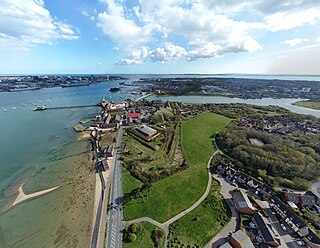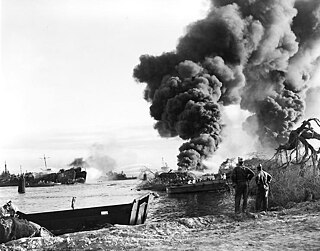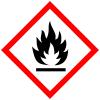Related Research Articles

Seeadler Harbor, also known as Port Seeadler, is located on Manus Island, Admiralty Islands, Papua New Guinea and played an important role in World War II. In German, "Seeadler" means sea eagle, pointing to German colonial activity between 1884 and 1919 in that area. The bay was named in 1900 after the German cruiser SMS Seeadler.

The Port Chicago disaster was a deadly munitions explosion of the ship SS E. A. Bryan on July 17, 1944, at the Port Chicago Naval Magazine in Port Chicago, California, United States. Munitions while being loaded onto a cargo vessel bound for the Pacific Theater of Operations, detonated killing 320 sailors and civilians and injuring 390 others. Two-thirds of the dead and injured were enlisted African American sailors.

A magazine is an item or place within which ammunition or other explosive material is stored. The word is taken originally from the Arabic word makhāzin (مخازن), meaning "storehouses", via Italian and Middle French.

USS Mount Hood (AE-11) was the lead ship of her class of ammunition ships for the United States Navy in World War II. She was the first ship named after Mount Hood, a volcano in the Cascade Range in the US state of Oregon. On 10 November 1944, shortly after 18 men had departed for shore leave, the rest of the crew were killed when the ship exploded in Seeadler Harbor at Manus Island in Papua New Guinea. The ship was obliterated while also sinking or severely damaging 22 smaller craft nearby.

USS Mauna Loa (AE-8) an ammunition ship in service with the United States Navy. She was commissioned from 1944 to 1947, and recommissioned between 1955 and 1958 and from 1960 to 1969. Mauna Loa was finally scrapped in 1984.

The USS Sangay (AE-10) was an ammunition ship in service with the United States Navy from 1943 to 1947. After spending decades in reserve, she was sold for scrapping in November 1980.
The Picatinny Arsenal is an American military research and manufacturing facility located on 6,400 acres (26 km2) of land in Jefferson and Rockaway Township in Morris County, New Jersey, United States, encompassing Picatinny Lake and Lake Denmark. The Arsenal is the headquarters of the US Army Combat Capabilities Development Command Armaments Center. It is known for developing the ubiquitous Picatinny rail, as well as being the Army's center of expertise for small arms cartridge ammunition.
There have been many extremely large explosions, accidental and intentional, caused by modern high explosives, boiling liquid expanding vapour explosions (BLEVEs), older explosives such as gunpowder, volatile petroleum-based fuels such as gasoline, and other chemical reactions. This list contains the largest known examples, sorted by date. An unambiguous ranking in order of severity is not possible; a 1994 study by historian Jay White of 130 large explosions suggested that they need to be ranked by an overall effect of power, quantity, radius, loss of life and property destruction, but concluded that such rankings are difficult to assess.

The Peters Cartridge Company was a company located along the Little Miami River in Kings Mills, Ohio, which specialized in gunpowder and ammunition production. Founded in 1887 by Gershom Moore Peters, the company supplied military ammunition to various countries during both world wars. Following its demise in 1944, the site was repurposed by Columbia Records and later Seagram, before being abandoned in 1968 and falling into disrepair. Its historic buildings, built in 1916, were added to the National Register of Historic Places in 1985. A brewery and apartment complex themed to the defunct company was constructed on site in 2020, in which many structures were restored and the company's history was placed on display for guests.

USS Serpens (AK-97) was a Crater-class cargo ship commissioned by the United States Navy for service in World War II. She was the first ship of the US Navy to have this name: she is named after Serpens, a constellation in the northern hemisphere. Serpens was crewed by United States Coast Guard personnel and was responsible for delivering troops, goods and equipment to locations in the Asiatic-Pacific Theater.

Priddy's Hard is a former military installation in Gosport, England named for the original landowner and the firm beach found there. The site originated as a 1750s fort, and then became an armaments depot for Royal Navy and British Army weapons, explosives and other stores. The site was decommissioned in 1988, after over two hundred years of operation, with part now being developed for housing and an area retained as a museum.

USS Solar (DE-221), a Buckley-class destroyer escort of the United States Navy, was named in honor of Boatswain's Mate First Class Adolfo Solar (1900–1941), who was killed in action during the Japanese attack on Pearl Harbor on 7 December 1941.
USS Vega (AK-17), was a Sirius-class cargo ship of the United States Navy, originally the Lebanon — a single-screw, steel-hulled Type 1022 freighter, built under a United States Shipping Board contract at Hog Island, Pennsylvania, by the American International Shipbuilding Co. Laid down on 8 July 1918, the ship was launched on 18 July 1919. Acquired by the Navy on 2 December 1921, she was renamed Vega and given the classification of AK-17. She fitted out for Navy service, and was commissioned at the Boston Navy Yard on 21 December 1921.

Ammunition is the material fired, scattered, dropped, or detonated from any weapon or weapon system. Ammunition is both expendable weapons and the component parts of other weapons that create the effect on a target.
A sympathetic detonation, also called flash over or secondary/secondaries (explosion), is a detonation, usually unintended, of an explosive charge by a nearby explosion.

The West Loch Disaster was a maritime accident during World War II at Pearl Harbor U.S. Naval Base in Hawaii. The incident, which occurred just after 3 p.m. on Sunday, 21 May 1944, began following an explosion in a staging area for Landing Ships, Tank (LSTs) and other amphibious assault ships in West Loch. A fire quickly spread among the ships being prepared for Operation Forager, the invasion of the Japanese-held Mariana Islands. Over the next 24 hours, six LSTs sank, 163 naval personnel died, and 396 were injured.

The SS Quinault Victory was the thirty-first Victory ship built by Oregon Shipbuilding Corporation in Portland, Oregon under the auspices of the Emergency Shipbuilding Program in support of America's involvement in World War II. Laid-down on 3 May 1944 and launched on 17 June), Quinault Victory was delivered to the War Shipping Administration and subsequently leased to the United States Lines Company.

SS El Estero was a ship filled with ammunition that caught fire at dockside in New York Harbor in 1943, but was successfully moved away and sunk by the heroic efforts of tugboat and fireboat crews, averting a major disaster.
YF-415 was a covered lighter in service with the United States Navy during World War II. It was accidentally sunk on May 11, 1944 while disposing of surplus explosive ordnance near Boston Harbor.
References
- ↑ Schiffer, Thomas D. (2002). Peters & King: The Birth & Evolution of the Peters Cartridge Co. & the King Powder Co. Iowa, Wisc.: Krause. pp. 62–68. ISBN 0-87349-363-X.
- 1 2 Hampton Road BlogSpot accessed September 27, 2018


